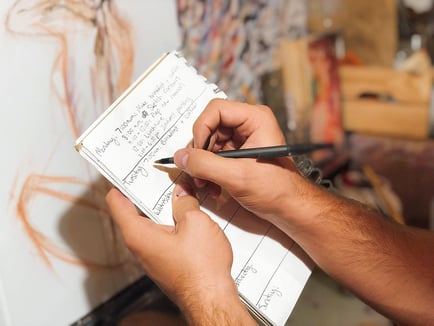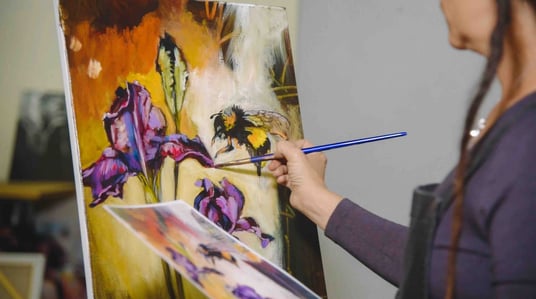
Photo caption: Art students and professional artists alike need good time management habits, like keeping a to-do list, if they want to succeed in their art careers.
All you’ve ever dreamed of is becoming a professional artist. To have the ability to be in control of your artistic prowess. To share your heart through your work. To use your days to create endless art.
When you’re creating art, time ceases to exist. You’re in a dream.
But wait...you have a full time job or a part time job, a family, a husband, meals to make, a workout to accomplish...where, oh where, is all your time?
Well, that is up to you.
Many artists struggle with time management. They want to paint, draw, create, but they run out of hours in the day.
If there is one thing we’ve said time and again to the art students who study at the Milan Art Institute, it’s this: In order to excel, planning is key. That includes planning their time.
It’s an essential principle for art students. And it’s essential for anyone who is interested in becoming a professional artist.
There are numerous ways to succeed at managing your time, and here are five that will help you better manage your time.✨
1. Time Block Your Day⏱
Time blocking is aptly named because it means to break up your day into blocks of time. Take similar activities and block off however much time you believe you need to accomplish those tasks.
For example, if it’s your time to paint, give yourself enough time that you can lose yourself in your painting. Conversely, knowing that there is a limit will drive you towards making progress. Ultimately, you should find the time of day that works best for you.
A few things to consider when deciding on your most productive hours are:
- when you generally have the most energy
- when you will be by yourself and will not be interrupted
- when you have accomplished personal tasks and are stress free.
Once you figure that out, block off those same times for each day of the week and make it a routine.💥
2. Create To-Do Lists to Stay Organized📑

Photo caption: How do you become a professional artist? Lots of painting AND a lot of planning.
If time blocking seems arduous, try to-do lists. Sit down weekly or daily and write a list of tasks that need to be completed that upcoming week or that day.
If you didn’t complete a task from the day before, add it to the next day’s list so that nothing is forgotten or lost as each day passes.
Make sure to check off these tasks as you complete them to give yourself a feeling of accomplishment. If you don’t want to hand-write to-do lists, you can check out apps such as Trello or To-doist, or simply use the calendar on your phone.
3. Bullet Journals: The Ultimate Time Management Journals
Another option you have is to create a time management journal. One excellent format for this is the bullet journal format.
The bullet journal is an analogue journal (as opposed to an app) that allows you to schedule your work, to brainstorm and to post reminders to yourself of your tasks.
This time management journal uses a series of dots, abbreviations, indexing and other time management tools and techniques. It’s a simple handwritten journal, and its system is designed to keep all of your tasks in one notebook.
Because of its simplicity, students and professionals alike find that it’s a time management system that’s easy to adopt.
If you’d like to learn more about how to create a bullet journal, the video below can help.
4. Treat Your Art Like a Job and Say “No” to Distractions🙅🏽♀️🙅🏽♂️

Photo caption: Tme management for professional artists isn’t that different from time management for art students. Both need to paint a lot to succeed.
One of the biggest barriers to time management that students in our Mastery Program face is a perceived lack of time.
Given that one of the premises of the Mastery Program is that we will teach our art students how to become a professional artist by the end of this one-year program, it is important that we teach them good time management habits.
That is, we recommend that Milan Art Institute students paint for 20 hours a week. Once they become professional artists, we suggest that they paint 40 hours a week.
We do that by teaching them some important time management principles, including this one:
Learn to manage your time as an artist by treating your creative time as a normal 9-5 job or an 8-hour shift.
When you have a “real” job, your friends and family know that you will not be available to hang out, get dinner, etc, until your work day is finished.
Respect yourself and your art in the same way. It is your job even if it is unconventional to others.
Try to eliminate the barriers to time management in your life: Forget the dishes in the sink. Put your phone away. Ignore the texts and calls you are bound to receive and focus on what you are creating.
We also suggest that you create a painting schedule that you plan on adhering to each week. Aside from helping you to eliminate your creative blocks, it’ll get you into the habit of treating painting like it’s your job.
This idea goes hand-in-hand with saying “no.” If a friend or family member called you at your day job wanting to hang out, you couldn’t and wouldn’t be able to drop everything to leave and see them.
Resolve to follow the same time management principles we ask our online students to follow. If art is your passion and your purpose, you owe it to yourself treat it as such.
Learn to say “no” and stick to the allotted time you’ve given yourself. Your friends and family will learn to respect your tenacity and conviction.
5. Stay Organized and Stay on Track👌🏽
Finally, don’t let a disorganized workspace take time away from your project. Looking for supplies such as pencils, brushes or paper may only take a few minutes, but these small interruptions add up, taking away time reserved for painting.
An inability to find what you need will either cut into your creative flow, or push your schedule out causing the next task or block of time to be thrown off.
Final Thoughts on Time Management Principles for Artists
While some time management practices and principles may seem hard to adopt at first, give yourself time to acclimate to a new routine.
If one doesn’t seem to work for you, try the other. You may be surprised to find that you save a great deal of time once you plan out each hour or each task.
More Information to Help You on Your Quest to Becoming a Professional Artist
👉 How to Create Sellable Artwork
